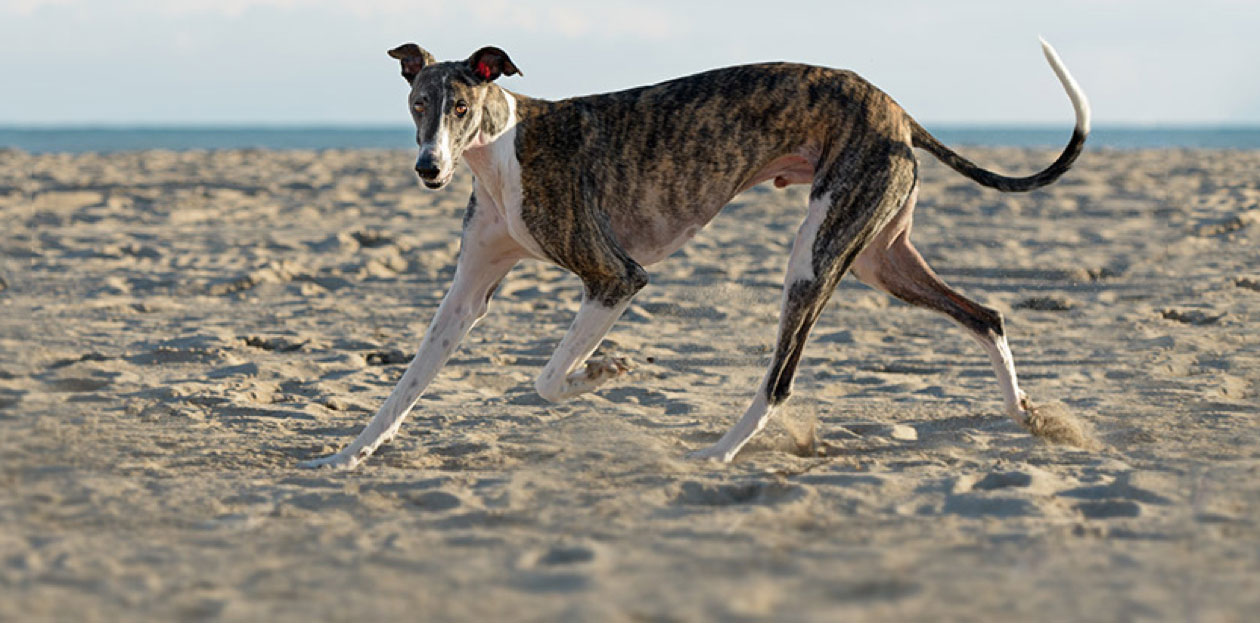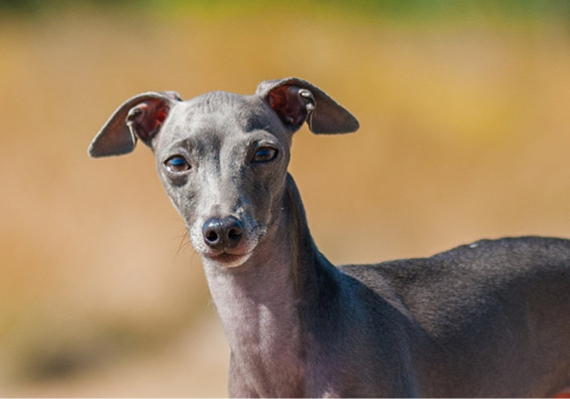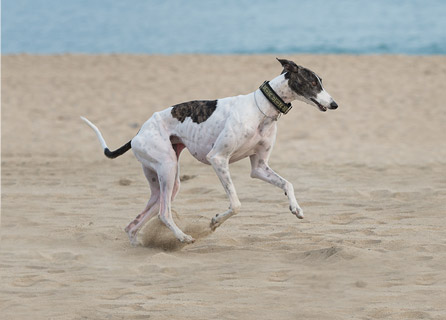
Greyhound breed guide
The Greyhound is one of the most recognisable breeds of dog for their sleek, slender frame and powerful runs, but their sweet and gentle nature makes them a great domestic pet too. Learn more about this quiet, affectionate dog, from their grooming and exercise needs, to the things you can do to keep them happy and healthy.
Breed information and advice
As the name suggests, the Greyhound belongs to the hound group and is the fastest breed around, with one racing dog clocking 45mph. Due to their short, thin coat, it’s important that they live indoors and may need a warm dog coat during winter.
- You might imagine that they're always on the go but the Greyhound can be just as happy lazing around the house.You might imagine that they're always on the go but the Greyhound can be just as happy lazing around the house.
- Regular grooming is important - despite their short coat, they shed a lot of hair.Regular grooming is important - despite their short coat, they shed a lot of hair.
- They'll typically weigh between 23kg and 39kg when fully grown.They'll typically weigh between 23kg and 39kg when fully grown.
- A healthy Greyhound will usually live for 12 to 15 years.A healthy Greyhound will usually live for 12 to 15 years.
Typical size of a Greyhound: Large: 63cm-76cm

Recommended exercise and nutrition
Your Greyhound doesn’t need to be zipping around all the time - just give them up to an hour a day of exercise and they’ll be happy with a couple of decent walks. They may need some encouragement to get up off the couch, so make sure they're regularly active - obesity can be a problem for retired Greyhounds. Socialising them as a puppy is also important to get them used to other dogs, but be patient and consistent as this breed has a sensitive side.
Feed your dog good quality food twice a day - how much will depend on their age, size and activity levels, and always read the packet instructions. Make sure you only leave out the food during feeding time to ward off any potential weight gain.
Up to one hour of exercise per day
An hour a day should be more than enough for your Greyhound - always use a lead as they have a strong prey instinct.

Common health problems and illnesses
Greyhounds are generally healthy dogs but they’ll need regular check-ups and vaccinations to stay in good shape. There are some conditions that this breed may be more prone to, and it’s worth being aware of the main symptoms, so you know what to watch out for.
If this occurs, it is an emergency situation where the dog’s stomach is filled with gas. The condition can cause the stomach to twist and if so, will require immediate surgery. If you notice any bloating around the stomach, dribbling or your dog is anxious, pacing and trying to vomit, then contact your vet. To help prevent this condition, you could split your dog’s food over several servings, raise their dog bowl and avoid any exercise after meals.
Dogs can get many of the same or similar oral diseases as are seen in people. However, whereas the most common dental disease in people is tooth decay or cavities, in dogs it is periodontal disease. Dogs with dental problems commonly show symptoms such as bad breath, excessive drooling, loss of appetite, and more.
As dog parents, we need to take good care of our dog’s teeth by regular brushing. We should also check our dog’s mouth regularly for early signs of dental problems. If you have any concerns, speak to your vet.
Because the Greyhound’s thin coat sheds so much, it leaves them less protected from the risk of cuts and scrapes. So if they tend to get excitable at playtime, or even if they're involved in rough and tumble with other animals, they could pick up a wound that requires attention. And because the Greyhound has extremely thin skin, with very little fatty tissue under the skin, when they get a wound it tends to be both longer and wider than with other breeds of dog. Keep any cuts clean to avoid the risk of infection.
Unlike most other dogs, Greyhounds can have problems with corns due to the sensitive pads of their feet. As they have very little fat between their foot’s pad and the bone, this condition can cause lameness. Corns are light or dark hardened circular patches, so check your dog’s paws regularly and speak to your vet if you suspect anything. Treatment options can range from ointment and cream to filing and surgery.
Osteosarcoma in dogs is primary bone cancer. The cancer originates in the bone and then spreads elsewhere. Frequently, the dog presents with lameness with or without other signs such as lethargy and weight loss. Rapid, progressive lameness needs an urgent consultation with a vet. X-ray is often the best diagnostic tool to use for finding bone cancers.
Find out about insurance for your Greyhound
Learn how pet insurance works and what kind of cover you might need for your dog.
Grooming advice
Because they shed so much, your Greyhound needs to be brushed daily in order to reduce the amount of stray hairs around the house. Daily brushing will also keep their coat looking lustrous.
Unless they have a habit of rolling in particularly mucky stuff, they won’t need to take a bath that often - once every 12 weeks will do the trick. Be sure to use a dog-friendly shampoo that won’t irritate their skin.
Due to their sensitive skin, it’s important to regularly check your Greyhound for cuts and scrapes to eliminate the risk of infection. Also check in and around their ears, and use an approved ear cleaner to keep them clean and fresh. Brush their teeth daily if you can, but at least a few times a week - plaque or tartar build-up is a potential problem for dogs just as it is for humans, and Greyhounds are particularly prone to dental disease. Regular brushing reduces bad breath too.
Fun and interesting facts
- The Greyhound is one of the oldest known breeds of dog - drawings of them have been found on walls in Ancient Egyptian tombs.
- Their chase instinct is one of the Greyhound’s defining qualities and owners need a solid fence to stop these dogs from taking off after small animals.
- Their thin skin makes Greyhounds sensitive to the cold - wrap yours up warmly if you’re expecting to spend a long time outside together.
- Greyhound racing exploded onto the UK scene during the 1920s. At one point, 100,000 people were visiting the White City track every week.
- Alongside their many royal owners throughout history, famous Greyhound owners - both real and fictional - include JK Rowling and Bart Simpson.
Important information
The content on this page aims to offer an informative introduction to pet breeds, but does not constitute expert veterinary advice. If your dog or cat falls ill or has an injury, contact your vet immediately.
All facts and figures were correct at date of publication and were compiled using a range of sources.
Discover more breeds
Browse our other cat and dog guides to learn about some of the UK’s most popular breeds.